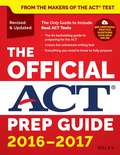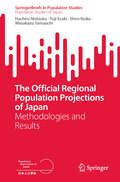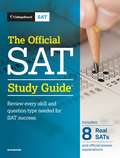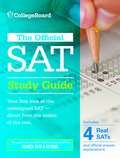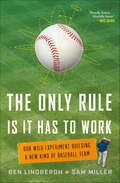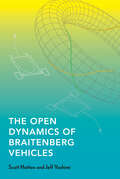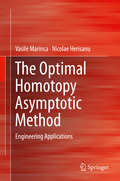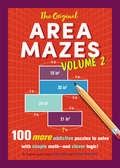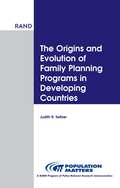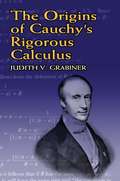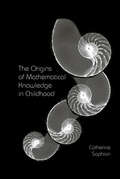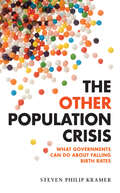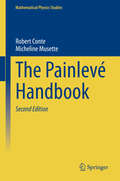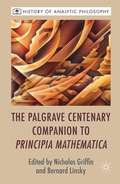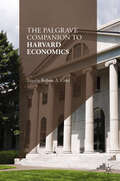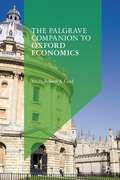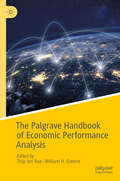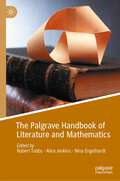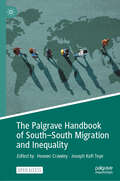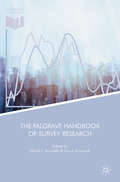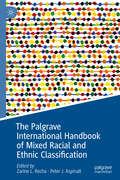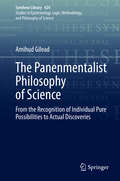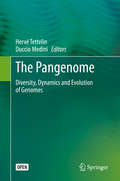- Table View
- List View
The Official ACT Prep Guide
by Jossey-Bass StaffEverything you need to know about the 2016-2017 ACT test, with real full-length practice tests from the makers of the ACT! The Official ACT Prep Guide 2016-2017 is the bestselling resource for students gearing up for the ACT test. This comprehensive guide walks you through the entire test experience, from registration through results, with expert advice straight from the test's creators. You'll find effective test-taking strategies, tips for boosting your score on the English, math, reading, and science tests, and detailed information on the enhanced optional writing test. Three new full-length practice tests help you assess your readiness so you can spot weak areas well in advance, and the ACT experts provide valuable advice on preparing both mentally and physically so you can manage anxiety and be fully confident on test day. You also get free online bonus content to help you start college on the right foot, including tips for preparing an application that gets noticed, getting into your first-choice school, being a successful student, and much more. The 2016-2017 version of the ACT guide includes a number of changes, including reading test sections with two shorter prose passages and the enhanced writing test's prompts. This guide provides a preview of what to expect for the entire exam, so you can go into the test feeling fully prepared and ready to excel.
The Official Regional Population Projections of Japan: Methodologies and Results (SpringerBriefs in Population Studies)
by Hachiro Nishioka Yuji Esaki Shiro Koike Masakazu YamauchiThis book focuses on the official regional population projections of Japan and examines its methodologies and results, written in English, by Japanese pioneers in this field for readers who are non-Japanese. In 2018, the National Institute of Population and Social Security Research (IPSS) issued Regional Population Projections for Japan: 2015–2045 (translated title), the only official projection actually released by the Japanese government. Obviously, the population development in the future contains essential information for regional societies. It serves not only for looking at the future of regional societies, but also as a basis for policy plans of local governments, private organizations, and other stakeholders. This present publication incorporates newer findings in the projections methods and the analysis of projection results. Population projection requires looking at three major elements: fertility, mortality, and migration. The migration factor is the most important, so the migration model is given the sharpest focus here. The text explains in an easy-to-understand manner what kinds of assumptions and models were used to produce this work. In addition, it considers the population changes of a future Japanese society in two categories, metropolitan and non-metropolitan areas of the country. At the same time, the book analyzes the demographic mechanisms of population change and aging by prefecture, and the regional distribution and growth patterns of the foreign population by prefecture and municipality.
The Official SAT Study Guide (2018 Edition)
by The College BoardReview every skill and question type needed for SAT success - now with eight total practice tests. The 2018 edition of The Official SAT Study Guide doubles the number of official SAT#65533; practice tests to eight - all of them created by the test maker. As part of the College Board's commitment to transparency, all practice tests are available on the College Board's website, but The Official SAT Study Guide is the only place to find them in print along with over 250 pages of additional instruction, guidance, and test information. With updated guidance and practice problems that reflect the most recent information, this new edition takes the best-selling SAT guide and makes it even more relevant and useful. Be ready for the SAT with strategies and up-to-date information straight from the exam writers. The Official SAT Study Guide will help students get ready for the SAT with: * 8 official SAT practice tests, written in the exact same process and by the same team of authors as the actual exam * detailed descriptions of the math and evidenced based reading and writing sections * targeted practice questions for each SAT question type * guidance on the new optional essay, including practice essay questions with sample responses * seamless integration with Official SAT Practice on Khan Academy There's also a complete chapter on the PSAT/NMSQT#65533;, which is aligned to the content and scores of the new SAT. The PSAT/NMSQT also has over $180 million of scholarships connected to student performance.
The Official SAT Study Guide, 2016 Edition
by The College BoardThe Official SAT Study Guide includes 4 official SAT® practice tests created by the test maker. As part of the College Board’s commitment to transparency, all four practice tests are available on the College Board’s website, but The Official SAT Study Guide is the only place to find them in print along with over 300 pages of additional instruction, guidance, and test information. Launching in March 2016, the new SAT introduces new question formats and content. Be ready with strategies and up-to-date information straight from the team that created the exam. Students will gain valuable experience and raise their confidence by taking practice tests, learning about test structure, and gaining a deeper understanding of what is tested on the SAT. The Official SAT Study Guide will help students get ready for the SAT with: • 4 official SAT practice tests, written in the exact same process and by the same team of authors as the actual exam • detailed descriptions of the math and evidenced based reading and writing sections of the SAT • targeted practice questions for each SAT question type • guidance on the new optional essay, including practice essay questions with sample responses • a review of math concepts tested in the exam • test-taking approaches and suggestions that underscore important points • seamless integration with Khan Academy's free SAT practice resources • scaled scoring for all 4 official SAT practice tests available in July on collegeboard.org There's also a complete chapter on the new PSAT/NMSQT®, which is aligned to the content and scores of the new SAT. The new PSAT/NMSQT also has over $180 million of scholarships connected to student performance. This is the guide for the new SAT that launches in March 2016 and the new PSAT/NMQST that launches in October 2015.
The Once And Future Turing
by Andrew Hodges S. Barry CooperAlan Turing (1912–1954) made seminal contributions to mathematical logic, computation, computer science, artificial intelligence, cryptography and theoretical biology. In this volume, outstanding scientific thinkers take a fresh look at the great range of Turing's contributions, on how the subjects have developed since his time, and how they might develop still further. The contributors include Martin Davis, J. M. E. Hyland, Andrew R. Booker, Ueli Maurer, Kanti V. Mardia, S. Barry Cooper, Stephen Wolfram, Christof Teuscher, Douglas Richard Hofstadter, Philip K. Maini, Thomas E. Woolley, Eamonn A. Gaffney, Ruth E. Baker, Richard Gordon, Stuart Kauffman, Scott Aaronson, Solomon Feferman, P. D. Welch and Roger Penrose. These specially commissioned essays will provoke and engross the reader who wishes to understand better the lasting significance of one of the twentieth century's deepest thinkers.
The Only Rule Is It Has to Work: Our Wild Experiment Building a New Kind of Baseball Team
by Ben Lindbergh Sam MillerThe New York Times bestseller about what would happen if two statistics-minded outsiders were allowed to run a professional baseball team.It’s the ultimate in fantasy baseball: You get to pick the roster, set the lineup, and decide on strategies -- with real players, in a real ballpark, in a real playoff race. That’s what baseball analysts Ben Lindbergh and Sam Miller got to do when an independent minor-league team in California, the Sonoma Stompers, offered them the chance to run its baseball operations according to the most advanced statistics. Their story in The Only Rule is it Has to Work is unlike any other baseball tale you've ever read.We tag along as Lindbergh and Miller apply their number-crunching insights to all aspects of assembling and running a team, following one cardinal rule for judging each innovation they try: it has to work. We meet colorful figures like general manager Theo Fightmaster and boundary-breakers like the first openly gay player in professional baseball. Even José Canseco makes a cameo appearance.Will their knowledge of numbers help Lindbergh and Miller bring the Stompers a championship, or will they fall on their faces? Will the team have a competitive advantage or is the sport’s folk wisdom true after all? Will the players attract the attention of big-league scouts, or are they on a fast track to oblivion?It’s a wild ride, by turns provocative and absurd, as Lindbergh and Miller tell a story that will speak to numbers geeks and traditionalists alike. And they prove that you don’t need a bat or a glove to make a genuine contribution to the game.
The Open Dynamics of Braitenberg Vehicles
by Jeff Yoshimi Scott HottonAn introduction to dynamical systems theory, a detailed mathematical analysis of pairs of Braitenberg vehicles, and a look at how these results apply to the study of physical and biological organisms.Powering the concept of a Braitenberg vehicle, developed in 1984 by the Italian-Austrian cyberneticist Valentino Braitenberg, is the idea that simple systems can produce complex behaviors. A pair of interacting Braitenberg vehicles is simple, but they can meander, wind around, and follow each another in a number of ways. In this book, Scott Hotton and Jeff Yoshimi show how dynamical systems theory—in particular the theory of open dynamic systems—can be used to analyze pairs of these vehicles in great detail. The result of the authors&’ long-standing collaboration at the intersection of mathematics, philosophy, cognitive science, and biology, The Open Dynamics of Braitenberg Vehicles offers a rigorous mathematical foundation for embodied cognition, especially when it comes to two-way interactions between an agent and its environment.Following an introduction to dynamical systems theory, and the most detailed mathematical analysis of Braitenberg vehicles to date, Hotton and Yoshimi discuss how their results can be applied to the study of physical and biological systems. They also describe their work's relevance to debates in the philosophy of embodied cognitive science. Combining the best features of embodied and representational approaches to cognitive science, complete with code and simulations, The Open Dynamics of Braitenberg Vehicles provides an extremely accessible and visually rich look into the workings and applications of open dynamical systems.
The Optimal Homotopy Asymptotic Method
by Nicolae Herisanu Vasile MarincaThis book emphasizes in detail the applicability of the Optimal Homotopy Asymptotic Method to various engineering problems. It is a continuation of the book "Nonlinear Dynamical Systems in Engineering: Some Approximate Approaches", published at Springer in 2011 and it contains a great amount of practical models from various fields of engineering such as classical and fluid mechanics, thermodynamics, nonlinear oscillations, electrical machines and so on. The main structure of the book consists of 5 chapters. The first chapter is introductory while the second chapter is devoted to a short history of the development of homotopy methods, including the basic ideas of the Optimal Homotopy Asymptotic Method. The last three chapters, from Chapter 3 to Chapter 5, are introducing three distinct alternatives of the Optimal Homotopy Asymptotic Method with illustrative applications to nonlinear dynamical systems. The third chapter deals with the first alternative of our approach with two iterations. Five applications are presented from fluid mechanics and nonlinear oscillations. The Chapter 4 presents the Optimal Homotopy Asymptotic Method with a single iteration and solving the linear equation on the first approximation. Here are treated 32 models from different fields of engineering such as fluid mechanics, thermodynamics, nonlinear damped and undamped oscillations, electrical machines and even from physics and biology. The last chapter is devoted to the Optimal Homotopy Asymptotic Method with a single iteration but without solving the equation in the first approximation.
The Original Area Mazes, Volume 2: 100 More Addictive Puzzles to Solve with Simple Math—and Clever Logic! (Original Area Mazes)
by Naoki Inaba Ryoichi MurakamiThe rules are simple . . . The math is easy . . . The puzzles get harder and harder! Hooked on area mazes? YOU’RE IN LUCK! Volume Two delivers 100 more puzzles. Your quest is to navigate a network of rectangles to find a missing value. Just remember: Area = length × widthUse spatial reasoning to find helpful relationshipsWhole numbers are all you need. You can always get the answer without using fractions! Originally invented for gifted students, area mazes have taken all of Japan by storm. Are you a sudoku fanatic? Do you play brain games to stay sharp? Did you love geometry . . . or would you like to finally show it who’s boss? Try area mazes—they could be just what you’re craving!
The Origins and Evolution of Family Planning Programs in Developing Countries
by Judith R. SeltzerThis book analyzes the origins and rationale of family planning programs and how they have evolved based on experience in different country settings.
The Origins of Cauchy's Rigorous Calculus (Dover Books on Mathematics)
by Judith V. GrabinerThis text for upper-level undergraduates and graduate students examines the events that led to a 19th-century intellectual revolution: the reinterpretation of the calculus undertaken by Augustin-Louis Cauchy and his peers. These intellectuals transformed the uses of calculus from problem-solving methods into a collection of well-defined theorems about limits, continuity, series, derivatives, and integrals. Beginning with a survey of the characteristic 19th-century view of analysis, the book proceeds to an examination of the 18th-century concept of calculus and focuses on the innovative methods of Cauchy and his contemporaries in refining existing methods into the basis of rigorous calculus. 1981 edition.
The Origins of Mathematical Knowledge in Childhood (Studies in Mathematical Thinking and Learning Series)
by Catherine SophianThis book examines the origins and development of children's mathematical knowledge. It contrasts the widely held view that counting is the starting point for mathematical development with an alternative comparison-of-quantities position. According to the comparison-of-quantities position, the concept of number builds upon more basic concepts of equality, inequality, and less-than and greater-than relations, which derive from comparisons between unenumerated quantities such as lengths. The concept of number combines these basic comparative concepts with the concept of a unit of measure, which allows one quantity to be described as a multiple of another. Sophian examines these alternative accounts of children's developing mathematical knowledge in the light of research: on children's counting; on their reasoning about continuous quantities such as length and area; on the development of the concept of unit; on additive and multiplicative reasoning; and on knowledge about fractions. In the closing chapters, Sophian draws out the developmental and the educational implications of the research and theory presented. Developmentally, the comparison-of-quantities position undermines the idea that numerical knowledge develops through domain-specific learning mechanisms in that it links numerical development both to physical knowledge about objects, which is the starting point for the concept of unit, and to the acquisition of linguistic number terms. Instructionally, the comparison-of-quantities perspective diverges from the counting-first perspective in that it underscores the continuity between whole-number arithmetic and fraction learning that stems from the importance of the concept of unit for both. Building on this idea, Sophian advances three instructional recommendations: First, instruction about numbers should always be grounded in thinking about quantities and how numbers represent the relations between them; second, instruction in the early years should always be guided by a long-term perspective in which current objectives are shaped by an understanding of their role in the overall course of mathematics learning; and third, instruction should be directly toward promoting the acquisition of the most general mathematical knowledge possible. The Origins of Mathematical Knowledge in Childhood is intended for researchers, professionals, and graduate students in developmental psychology, educational psychology, and mathematics education, and as a supplementary text for advanced undergraduate courses in cognitive development, educational psychology, and mathematics education.
The Other Population Crisis: What Governments Can Do about Falling Birth Rates
by Steven Philip KramerIn many developed countries, population decline poses economic and social strains and may even threaten national security. Through historical-political case studies of Sweden, France, Italy, Japan, and Singapore, The Other Population Crisis explores the motivations, politics, programming, and consequences of national efforts to promote births. Steven Philip Kramer finds a significant government role in stopping declines in birth rates. Sweden’s and France’s pro-natalist programs, which have succeeded, share the characteristics of being universal, not means-tested, and based on gender equality and making it easy for women to balance work and family. The programs in Italy, Japan, and Singapore, which have failed so far, have not devoted sufficient resources consistently enough to make a difference and do not support gender equality and women’s work-family balance, Kramer finds.
The Painlevé Handbook (Mathematical Physics Studies)
by Robert Conte Micheline MusetteThis book, now in its second edition, introduces the singularity analysis of differential and difference equations via the Painlevé test and shows how Painlevé analysis provides a powerful algorithmic approach to building explicit solutions to nonlinear ordinary and partial differential equations. It is illustrated with integrable equations such as the nonlinear Schrödinger equation, the Korteweg-de Vries equation, Hénon-Heiles type Hamiltonians, and numerous physically relevant examples such as the Kuramoto-Sivashinsky equation, the Kolmogorov-Petrovski-Piskunov equation, and mainly the cubic and quintic Ginzburg-Landau equations. Extensively revised, updated, and expanded, this new edition includes: recent insights from Nevanlinna theory and analysis on both the cubic and quintic Ginzburg-Landau equations; a close look at physical problems involving the sixth Painlevé function; and an overview of new results since the book’s original publication with special focus on finite difference equations. The book features tutorials, appendices, and comprehensive references, and will appeal to graduate students and researchers in both mathematics and the physical sciences.
The Palgrave Centenary Companion To Principia Mathematica
by Nicholas Griffin Bernard LinskyTo mark the centenary of the 1910 to 1913 publication of the monumental Principia Mathematica by Alfred N. Whitehead and Bertrand Russell, this collection of fifteen new essays by distinguished scholars considers the influence and history of PM over the last hundred years.
The Palgrave Companion to Harvard Economics
by Robert A. CordHarvard University has been and continues to be one of the most important global centres for economics. With three chapters on themes in Harvard economics and 41 chapters on the lives and work of Harvard economists, these two volumes show how economics became established at the University, how it produced some of the world’s best-known economists, including Joseph Schumpeter, Wassily Leontief and John Kenneth Galbraith, and how it remains a global force for the very best in teaching and research in economics. With original contributions from a stellar cast, the volumes provide economists – especially those interested in macroeconomics and the history of economic thought – with an in-depth analysis of Harvard economics.
The Palgrave Companion to Oxford Economics
by Robert A. CordThe University of Oxford has been and continues to be one of the most important global centres for economics. With six chapters on themes in Oxford economics and 24 chapters on the lives and work of Oxford economists, this volume shows how economics became established at the University, how it produced some of the world’s best-known economists, including Francis Ysidro Edgeworth, Roy Harrod and David Hendry, and how it remains a global force for the very best in teaching and research in economics. With original contributions from a stellar cast, this volume provides economists – especially those interested in macroeconomics and the history of economic thought – with the first in-depth analysis of Oxford economics.
The Palgrave Companion to the Philosophy of Set Theory (Palgrave Companions)
by Giorgio Venturi Carolin Antos Neil BartonThis volume showcases some of the up-and-coming voices of an emerging field - the philosophy of set theory - which in recent years has gained prominence in the philosophy of mathematics. The chapters in this volume both present new topics and propose solutions to old problems. It contains a broad picture of the philosophy of set theory, examining questions from epistemology and ontology, whilst touching on the use of formal theories in the study of mathematical infinity. Key features of this volume: • Explores new and interesting connections between philosophy, set theory, and the study of infinity. • Considers questions intended to appeal to a wider audience in both philosophy and mathematical logic. • Examines three key areas of study: Epistemology, Formal Theories, and Ontology. The book provides a key reference text for future debates and is ideal for both newcomers to the philosophy of set theory and established researchers in the field.
The Palgrave Handbook of Economic Performance Analysis
by William H. Greene Thijs Ten RaaThis Handbook takes an econometric approach to the foundations of economic performance analysis. The focus is on the measurement of efficiency, productivity, growth and performance. These concepts are commonly measured residually and difficult to quantify in practice. In real-life applications, efficiency and productivity estimates are often quite sensitive to the models used in the performance assessment and the methodological approaches adopted by the analysis. The Palgrave Handbook of Performance Analysis discusses the two basic techniques of performance measurement – deterministic benchmarking and stochastic benchmarking – in detail, and addresses the statistical techniques that connect them. All chapters include applications and explore topics ranging from the output/input ratio to productivity indexes and national statistics.
The Palgrave Handbook of Literature and Mathematics
by Nina Engelhardt Alice Jenkins Robert TubbsThis handbook features essays written by both literary scholars and mathematicians that examine multiple facets of the connections between literature and mathematics. These connections range from mathematics and poetic meter to mathematics and modernism to mathematics as literature. Some chapters focus on a single author, such as mathematics and Ezra Pound, Gertrude Stein, or Charles Dickens, while others consider a mathematical topic common to two or more authors, such as squaring the circle, chaos theory, Newton’s calculus, or stochastic processes. With appeal for scholars and students in literature, mathematics, cultural history, and history of mathematics, this important volume aims to introduce the range, fertility, and complexity of the connections between mathematics, literature, and literary theory.
The Palgrave Handbook of South–South Migration and Inequality
by Heaven Crawley Joseph Kofi TeyeThis open access handbook examines the phenomenon of South-South migration and its relationship to inequality in the Global South, where at least a third of all international migration takes place. Drawing on contributions from nearly 70 leading migration scholars, mainly from the Global South, the handbook challenges dominant conceptualisations of migration, offering new perspectives and insights that can inform theoretical and policy understandings and unlock migration’s development potential. The handbook is divided into four parts, each highlighting often overlooked mobility patterns within and between regions of the Global South, as well as the inequalities faced by those who move. Key cross-cutting themes include gender, race, poverty and income inequality, migration decision making, intermediaries, remittances, technology, climate change, food security and migration governance. The handbook is an indispensable resource on South-South migration and inequality for academics, researchers, postgraduates and development practitioners.
The Palgrave Handbook of Survey Research
by Jon A. Krosnick David L. VannetteThis handbook is a comprehensive reference guide for researchers, funding agencies and organizations engaged in survey research. Drawing on research from a world-class team of experts, this collection addresses the challenges facing survey-based data collection today as well as the potential opportunities presented by new approaches to survey research, including in the development of policy. It examines innovations in survey methodology and how survey scholars and practitioners should think about survey data in the context of the explosion of new digital sources of data. The Handbook is divided into four key sections: the challenges faced in conventional survey research; opportunities to expand data collection; methods of linking survey data with external sources; and, improving research transparency and data dissemination, with a focus on data curation, evaluating the usability of survey project websites, and the credibility of survey-based social science. Chapter 23 of this book is open access under a CC BY 4. 0 license at link. springer. com.
The Palgrave International Handbook of Mixed Racial and Ethnic Classification
by Peter J. Aspinall Zarine L. RochaThis handbook provides a global study of the classification of mixed race and ethnicity at the state level, bringing together a diverse range of country case studies from around the world. The classification of race and ethnicity by the state is a common way to organize and make sense of populations in many countries, from the national census and birth and death records, to identity cards and household surveys. As populations have grown, diversified, and become increasingly transnational and mobile, single and mutually exclusive categories struggle to adequately capture the complexity of identities and heritages in multicultural societies. State motivations for classification vary widely, and have shifted over time, ranging from subjugation and exclusion to remediation and addressing inequalities. The chapters in this handbook illustrate how differing histories and contemporary realities have led states to count and classify mixedness in different ways, for different reasons. This collection will serve as a key reference point on the international classification of mixed race and ethnicity for students and scholars across sociology, ethnic and racial studies, and public policy, as well as policy makers and practitioners.
The Panenmentalist Philosophy of Science: From the Recognition of Individual Pure Possibilities to Actual Discoveries (Synthese Library #424)
by Amihud GileadThis book presents a philosophy of science, based on panenmentalism: an original modal metaphysics, which is realist about individual pure (non-actual) possibilities and rejects the notion of possible worlds. The book systematically constructs a new and novel way of understanding and explaining scientific progress, discoveries, and creativity. It demonstrates that a metaphysics of individual pure possibilities is indispensable for explaining and understanding mathematics and natural sciences. It examines the nature of individual pure possibilities, actualities, mind-dependent and mind-independent possibilities, as well as mathematical entities. It discusses in detail the singularity of each human being as a psychical possibility. It analyses striking scientific discoveries, and illustrates by means of examples of the usefulness and vitality of individual pure possibilities in the sciences.
The Pangenome: Diversity, Dynamics and Evolution of Genomes
by Hervé Tettelin Duccio MediniThis open access book offers the first comprehensive account of the pan-genome concept and its manifold implications. The realization that the genetic repertoire of a biological species always encompasses more than the genome of each individual is one of the earliest examples of big data in biology that opened biology to the unbounded. The study of genetic variation observed within a species challenges existing views and has profound consequences for our understanding of the fundamental mechanisms underpinning bacterial biology and evolution. The underlying rationale extends well beyond the initial prokaryotic focus to all kingdoms of life and evolves into similar concepts for metagenomes, phenomes and epigenomes. The book’s respective chapters address a range of topics, from the serendipitous emergence of the pan-genome concept and its impacts on the fields of microbiology, vaccinology and antimicrobial resistance, to the study of microbial communities, bioinformatic applications and mathematical models that tie in with complex systems and economic theory. Given its scope, the book will appeal to a broad readership interested in population dynamics, evolutionary biology and genomics.
